|
|
|
Sort Order |
|
|
|
Items / Page
|
|
|
|
|
|
|
| Srl | Item |
| 1 |
ID:
166718
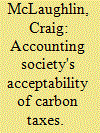

|
|
|
|
|
| Summary/Abstract |
This article seeks to examine accountants' perceptions of carbon taxes in addressing climate change. Specifically, it aims at (i) a better understanding of accountants opinions on carbon taxes; (ii) how energy companies have adapted their business operations since introducing carbon tax. The article's primary sources of data are (1) a 2018 survey distributed to 45 accounting professionals in Scotland, which specialise in energy finance and a formal interview with a regional finance director of a multinational energy company. The results show how the accountants are in favour the carbon tax due to its positive environmental impact, however, do not agree with the associated rising utility costs. Though, carbon tax, from an energy business' perspective, is viewed negatively due to its effects on the end users of energy. This study contributes to the current research by demonstrating the role of accounting society in boosting public awareness of climate change. The findings of this study will help regulators and policy makers in the UK to evaluate the adequacy of current carbon tax reforms and to promote the public awareness of climate change to reduce carbon emissions.
|
|
|
|
|
|
|
|
|
|
|
|
|
|
|
|
| 2 |
ID:
137697


|
|
|
|
|
| Summary/Abstract |
The CA-TIMES optimization model of the California Energy System (v1.5) is used to understand how California can meet the 2050 targets for greenhouse gas (GHG) emissions (80% below 1990 levels). This model represents energy supply and demand sectors in California and simulates the technology and resource requirements needed to meet projected energy service demands. The model includes assumptions on policy constraints, as well as technology and resource costs and availability. Multiple scenarios are developed to analyze the changes and investments in low-carbon electricity generation, alternative fuels and advanced vehicles in transportation, resource utilization, and efficiency improvements across many sectors. Results show that major energy transformations are needed but that achieving the 80% reduction goal for California is possible at reasonable average carbon reduction cost ($9 to $124/tonne CO2e at 4% discount rate) relative to a baseline scenario. Availability of low-carbon resources such as nuclear power, carbon capture and sequestration (CCS), biofuels, wind and solar generation, and demand reduction all serve to lower the mitigation costs, but CCS is a key technology for achieving the lowest mitigation costs.
|
|
|
|
|
|
|
|
|
|
|
|
|
|
|
|
| 3 |
ID:
111350
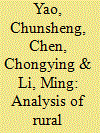

|
|
|
|
|
| Publication |
2012.
|
| Summary/Abstract |
The analysis of rural residential energy consumption in China from 2001 to 2008 and corresponding impacts on climate change is presented in the paper. It is found that rural residential energy consumption has shown obvious transition from non-commercial energy to commercial energy. The percentage of biomass energy consumption dropped from 81.5% in 2001 to 70.9% in 2008, while the percentage of commercial energy increased from 17.1% to 25.1%. Besides, other renewable energy increased very fast with annual growth rate of 19.8%. Correspondingly, total CO2 emissions from rural residential energy consumption had significant increase from 152.2 Million tons in 2001 to 283.6 Million tons in 2008. The annual growth rate of per capita CO2 emissions was nearly 2 times faster than that of urban area. The major driving force for the consumption of commercial energy was the income of rural farmers, while strong rural energy policies supported the development of renewable energy. To satisfy the goals of energy supply and CO2 emissions reduction in rural areas, it is advised to change the energy structure and improve the energy efficiency, such as to generate electricity using renewable technologies and to replace coal with modern biomass energy for cooking and heating.
|
|
|
|
|
|
|
|
|
|
|
|
|
|
|
|
| 4 |
ID:
192705


|
|
|
|
|
| Summary/Abstract |
The environmental impact of the transport sector has a significant contribution in the carbon emissions. To reduce fossil fuel consumption and promote clean fuel, many countries are considering hydrogen as an alternative fuel and a bridge to sustainable development and achieve net zero target. Indian government has taken multiple policy initiatives to promote hydrogen fuel adoption in India. But nevertheless, the major presence of the multiple barriers limits the mass adoption of hydrogen as a preferred fuel. Therefore, identification and assessment of the key internal and external barriers of the hydrogen fuel vehicles adoption is required to mitigate the climate change issues. This study has identified and analyzed the barriers. The criticality assessment of the barriers is done by fuzzy based hybrid approach analytic hierarchy process. Later, sensitivity experiments are conducted to verify the robustness of the model. The findings of the study show that technical barriers are most critical barriers in the adoption of hydrogen fuel vehicles in India. The result of the study also indicates that India would require to build the hydrogen supply network and infrastructure, improve consumer awareness, favourable policies and develop efficient production technology for the mass adoption of hydrogen as a fuel.
|
|
|
|
|
|
|
|
|
|
|
|
|
|
|
|
| 5 |
ID:
181459
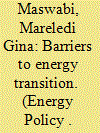

|
|
|
|
|
| Summary/Abstract |
Low carbon development involves profound changes in existing countries’ governing structures. Recent studies have shown that significant benefits to low carbon development in developing countries can be achieved from energy sector transitions. This paper argues that energy transition in Botswana which involves reduction of dependence on coal-generated electricity and increase in the uptake of solar energy can only be achieved through regime-based reconfigurations driven by deliberate government action and political will. It draws on energy transition literature to examine whether existing policy instruments can drive the desired transition. Through in-depth qualitative analysis, it identifies barriers that impede transition attempts to date. As an effort to overcome regime level barriers in particular, the paper proposes several low-cost changes in the existing electricity regime to facilitate a wider energy sector transformation.
|
|
|
|
|
|
|
|
|
|
|
|
|
|
|
|
| 6 |
ID:
192750
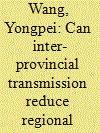

|
|
|
|
|
| Summary/Abstract |
Plagued by worsening pollution in load centers along the eastern coastal regions such as Beijing-Tianjin -Hebei, China is reducing local coal-fired power plants in those regions and relying more on inter-regional power transmission. In recent years, China has accelerated the construction of the West-East Electricity Transmission Project and planned and constructed a number of Ultra-high Voltage (UHV) transmission lines. However, how the impact of inter-regional transmission on carbon emissions needs empirical verification. This paper aims to study the carbon emission reduction effect of inter-regional transmission under nested models of the spatial econometric model for panel data. The empirical results show that although the non-dynamic spatial econometric analysis can find the carbon emission reduction effect of inter-provincial transmission, the long-term effect obtained by the dynamic spatial econometric analysis indicates that the inter-provincial transmission can bring about a slight increase in carbon emissions. The inter-provincial power transmission needs to be supported by sustainable share growth of renewable energy to achieve the targeted mitigation of carbon emissions.
|
|
|
|
|
|
|
|
|
|
|
|
|
|
|
|
| 7 |
ID:
150005


|
|
|
|
|
| Summary/Abstract |
This study investigates the long and short run relationships among carbon emissions, energy consumption and economic growth in India at the aggregated and disaggregated levels during 1971–2014. The autoregressive distributed lag model is employed for the cointegration analyses and the vector error correction model is applied to determine the direction of causality between variables. Results show that a long run cointegration relationship exists and that the environmental Kuznets curve is validated at the aggregated and disaggregated levels. Furthermore, energy (total energy, gas, oil, electricity and coal) consumption has a positive relationship with carbon emissions and a feedback effect exists between economic growth and carbon emissions. Thus, energy-efficient technologies should be used in domestic production to mitigate carbon emissions at the aggregated and disaggregated levels. The present study provides policy makers with new directions in drafting comprehensive policies with lasting impacts on the economy, energy consumption and environment towards sustainable development.
|
|
|
|
|
|
|
|
|
|
|
|
|
|
|
|
| 8 |
ID:
059113
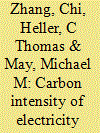

|
|
|
| 9 |
ID:
181526


|
|
|
|
|
| Summary/Abstract |
This article looks at the current state of carbon removal approaches and some of the politics that surround them. It outlines what carbon removal is, charts some of the major challenges and controversies, and sketches some of the work needed to ensure that carbon removal developments are attentive to environmental sustainability and social justice. It also examines some of the major carbon removal options that are either in development or in discussion, starting with biological approaches and then looking at engineered options.
|
|
|
|
|
|
|
|
|
|
|
|
|
|
|
|
| 10 |
ID:
089901
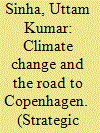

|
|
|
|
|
| Publication |
2009.
|
| Summary/Abstract |
The Road to Copenhagen in December 2009 has two visible signposts. One that reads, 'The time for climate change action is now', the other that warns, 'The road is bumpy'. The first signpost expresses the apocalyptic language that the earth's rising temperatures are poised to set off irreversible consequences if concrete steps are not taken quickly. It suggests that the climate is nearing tipping point. The second signpost forewarns that arriving at a bold, equitable, and binding treaty will not be easy and that the politics of climate change will undermine the science of climate change. Irrespective of whether the climate change probability is high, medium, or low, arriving at a consensus in Copenhagen from December 7-18, referred to as the 'Son of Kyoto', will clearly test the tenor of the international community in involving a framework beyond 2012. Any expected 'grand deal' will structure around four contested issues.
|
|
|
|
|
|
|
|
|
|
|
|
|
|
|
|
| 11 |
ID:
133271


|
|
|
|
|
| Publication |
2014.
|
| Summary/Abstract |
In light of the growth in vertically specialized in global trade, the present paper uses input- output tables from the World Input-Output Database to construct an environmental multi-regional input-output model to calculate the CO2 emissions embodied in China's international trade during 1995-2009. The advantage of this model lies in its incorporation of the re-exported CO2 emissions component embodied in trade and its ability to differentiate domesticsourced CO2 emissions from foreign-sourced CO2 emissions in trade. The results show that carbon emissions embodied in both China's exports and imports increased significantly during 1995-2009. One important reason for this is that the re-exported carbon emissions embodied in China's imported intermediate inputs increased substantially during this period. Our research reveals that accelerating the transformation of trade pattern and upgrading processing trade should be emphasized in the formulation of policy to prompt CO2 emissions abatement in China.
|
|
|
|
|
|
|
|
|
|
|
|
|
|
|
|
| 12 |
ID:
176896
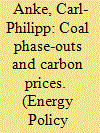

|
|
|
|
|
| Summary/Abstract |
The European Union Emission Trading System (EU ETS) constitutes the core instrument of the European Union climate protection policy. It limits greenhouse gas emissions of its member states and aims at facilitating an efficient allocation of emission reduction across national borders. Accompanying this policy at the European level, individual member states have introduced national mitigation policies, including renewable energy (RES) expansion measures or coal phase-outs.
|
|
|
|
|
|
|
|
|
|
|
|
|
|
|
|
| 13 |
ID:
091567
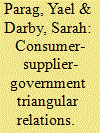

|
|
|
|
|
| Publication |
2009.
|
| Summary/Abstract |
The UK residential (household) sector is responsible for approximately 30% of total carbon dioxide emissions and is often seen as the most promising in terms of early reductions. As most direct household emissions come from only two fuel sources, this paper critically examines how existing emissions reduction policies for the sector shape - and are shaped by - relations between the three main groups of actor in this policy domain: central government, gas and electricity suppliers, and energy users. Focusing on relations between three dyads (government-suppliers, suppliers-consumers and consumers-government) enables us to examine aspects of demand reduction that have often been overlooked to date. By 'relations' we refer to services, power relationships and flows of capital and information, as well as less easily defined elements such as loyalty, trust and accountability. The paper argues that the chosen government policy path to deliver demand reduction, which heavily emphasises the suppliers' role, suffers from principal-agent problems, fails to align consumers and supplier interests toward emissions reduction, and does not yet portray a lower-carbon future in positive terms. It suggests that more attention should be paid to government-consumer relations, recognising that energy consumers are also citizens.
|
|
|
|
|
|
|
|
|
|
|
|
|
|
|
|
| 14 |
ID:
119823


|
|
|
|
|
| Publication |
2013.
|
| Summary/Abstract |
The paper investigates the contributions of foreign direct investment (FDI) net inflows to clean energy use, carbon emissions, and economic growth. The paper employs cointegration tests to examine a long-run equilibrium relationship among the variables and fixed effects models to examine the magnitude of FDI contributions to the other variables. The paper analyzes panel data of 19 nations of the G20 from 1971 to 2009. The test results indicate that FDI has played an important role in economic growth for the G20 whereas it limits its impact on an increase in CO2 emissions in the economies. The research finds no compelling evidence of FDI link with clean energy use. Given the results, the paper discusses FDI's potential role in achieving green growth goals.
|
|
|
|
|
|
|
|
|
|
|
|
|
|
|
|
| 15 |
ID:
125444
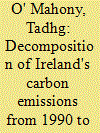

|
|
|
|
|
| Publication |
2013.
|
| Summary/Abstract |
In recent decades, Ireland has been an important example of a development pathway where rapid economic growth was accompanied by rising energy demand and increasing carbon emissions. Understanding the driving forces of carbon emissions is necessary for policy formulation and decomposition analysis is widely used for this purpose. This study uses an extended Kaya identity as the scheme and applies the log mean Divisia index (LMDI I) as the decomposition technique. Change in carbon emissions is decomposed from 1990 to 2010 and includes a measure of the effect of renewable energy penetration. Results illustrate that scale effects of affluence and population growth act to increase emissions and are countered primarily by energy intensity and fossil fuel substitution. Renewable energy penetration has a minor effect but has been increasing in recent years. Policy will need to significantly reduce intensity and increase renewables if applicable targets are to be reached. This requires not only a comprehensive suite of policies and measures but emphasis on the development path and 'non-technical' change for optimal outcomes.
|
|
|
|
|
|
|
|
|
|
|
|
|
|
|
|
| 16 |
ID:
132604


|
|
|
|
|
| Publication |
2014.
|
| Summary/Abstract |
The United Kingdom is aspiring to reduce the carbon emissions in the building sector, aiming to achieve nearly zero carbon buildings by 2020. The policy models in England and Wales rely on three strands: regulations; financial incentives and educational schemes. A growing body of literature suggests that the building industry is facing several barriers that hinder the delivery of the expected carbon targets outlined at policy level. This research explores the enactment of the policy aspirations by building designers using a bottom-up approach. An ethnographic study was conducted to analyse the design process of six non-domestic buildings. The work identified the designers× responses to adopt the policy agenda in routine design and overcome the challenges that emerged during the design process. The understanding of the designers× responses could inform the policy model and suggest areas that need attention for the timely delivery of the expected carbon reductions.
|
|
|
|
|
|
|
|
|
|
|
|
|
|
|
|
| 17 |
ID:
186460
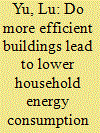

|
|
|
|
|
| Summary/Abstract |
Over the last decade, residential energy consumption has become a major contributor to global energy use and carbon emissions, and its contributions, especially in developing regions, are accelerating more rapidly than those of the industrial sector. The energy efficiency of the building stock has shown great potential for reducing household energy consumption through advanced measures on the envelopes of buildings, such as the use of advanced construction materials and improvements in building structures. Thus, policies have been implemented to improve energy efficiency and reduce carbon emissions from buildings. This paper analyses survey data from Guangzhou, a megacity with a subtropical climate in South China, to estimate the effects of energy efficiency on the energy consumption of residential buildings. We apply an econometric approach to examine the effects of energy efficiency, and we employ instrumental variables to address problems of endogeneity. The results show that greener buildings, in terms of advanced building materials and structures oriented towards high energy efficiency, reduce the carbon footprints of households. Additionally, households with low income levels and those with environmentally friendly energy consumption behaviour are likely to benefit from living in energy efficient buildings more than other households. Finally, suggestions on ways to improve energy policy and methods to reduce household energy consumption and carbon (CO2) emissions are presented.
|
|
|
|
|
|
|
|
|
|
|
|
|
|
|
|
| 18 |
ID:
187875
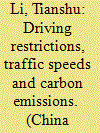

|
|
|
|
|
| Summary/Abstract |
We investigate the effect of driving restrictions on traffic speeds and calculate the implied reduction in carbon emissions using empirical evidence from the city of Xi'an in China. We obtain high-frequency road-section-level transportation data from the Didi Chuxing Technology Company and use a regression discontinuity design (RDD) to identify the causal effect of driving restrictions on vehicle cruising speeds by exploiting a policy variation in 2018. We find that the driving restrictions led to an increase in vehicle cruising speeds of up to 15–20% during peak hours, which consequently dramatically reduced carbon emissions. Based on our back-of-the-envelope calculations, carbon emissions from private vehicles could be reduced by 2.2–5.8% thanks to increased fuel efficiency due to less traffic congestion.
|
|
|
|
|
|
|
|
|
|
|
|
|
|
|
|
| 19 |
ID:
154167


|
|
|
|
|
| Summary/Abstract |
This research utilises an improved dynamic panel model to investigate the environmental effect of different technological resources in the big three regions of China, i.e. the eastern, western and central regions, from 1990 to 2014. The results show that research and development (R&D) capital stock contributes the most to the reduction of carbon emissions, whether at the national or provincial level, but physical capital stock results in an evident increment of carbon emissions in the three regions, especially in eastern China. Human capital stock, on the other hand, causes some mitigation in eastern and central China, except for western China. The spillover of international technology stock from foreign direct investment has less effect on carbon emission abatement than does import trade, though there are distinct regional differences.
|
|
|
|
|
|
|
|
|
|
|
|
|
|
|
|
| 20 |
ID:
103344
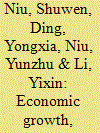

|
|
|
|
|
| Publication |
2011.
|
| Summary/Abstract |
This study was conducted to evaluate the causality between energy consumption, GDP growth and carbon emissions for eight Asia-Pacific countries from 1971 to 2005 using the panel data. The results indicate that there are long-run equilibrium relationships between these variables. Additionally, causality from energy consumption to CO2 emissions was observed generally, but there were some opposite relationships also. Parameter estimations of the panel data model indicate that there are great differences in the carbon emissions, the efficiencies of energy use, carbon emissions of unit GDP and unit energy consumption between developed and developing countries. The base carbon emissions, per capita energy consumption and efficiency of energy use in developing countries are far lower than in developed countries; however, the CO2 emissions per unit of energy use is higher. Although developing countries may reduce their CO2 emission per unit energy use, total energy consumption will rise rapidly with economic development. Thus, developing countries must determine how to undergo economic growth while conserving energy and reducing emissions. To respond to global climate change, it is necessary to develop innovative technology for energy use, transform the energy structure and conduct the clean development mechanism.
|
|
|
|
|
|
|
|
|
|
|
|
|
|
|
|
|
|
|
|
|